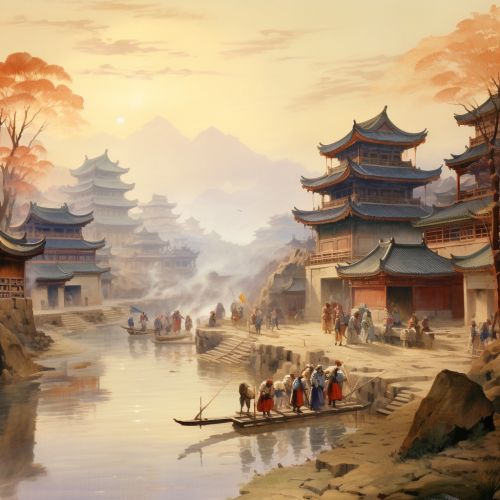Zhou dynasty
Origins and History
The Zhou dynasty was a significant era in the history of ancient China, lasting from 1046 to 256 BC. It followed the Shang dynasty and was succeeded by the Qin dynasty. The Zhou dynasty is divided into two distinct periods: Western Zhou (1046–771 BC) and Eastern Zhou (770–256 BC).


The Zhou dynasty was established by King Wu, who led a rebellion against the last Shang king, King Zhou. After the successful rebellion, King Wu and his brother, the Duke of Zhou, established a new political order that was characterized by the decentralization of power. This system, known as the feudal system, allowed the Zhou dynasty to control and govern a vast territory that extended across the Yellow River and Yangtze River valleys.
Political Structure
The political structure of the Zhou dynasty was characterized by the feudal system. In this system, the Zhou kings granted lands to their relatives and allies, who in turn pledged loyalty and military support to the king. These landholders, known as lords, ruled their territories as semi-independent states. This system of governance allowed the Zhou dynasty to maintain control over a vast territory, but it also led to internal conflicts and power struggles.
The Zhou dynasty also introduced the concept of the Mandate of Heaven, which was used to justify the rule of the king. According to this belief, the king was chosen by the gods to rule because of his virtue and ability. If a king was unjust, it was believed that he could lose the Mandate of Heaven and be overthrown.
Culture and Society
The Zhou dynasty was a time of great cultural and societal development. The Confucian and Taoist philosophies, which continue to influence Chinese culture today, were developed during this period. The Zhou dynasty also saw advancements in literature, music, and art.
The society of the Zhou dynasty was hierarchical, with the king at the top, followed by the nobility, the commoners, and the slaves. The family was the basic unit of society, and filial piety was a central value. The Zhou dynasty also saw the development of a written legal code, which helped to maintain social order.
Economy
The economy of the Zhou dynasty was based on agriculture, with the cultivation of rice, wheat, and millet being the primary activities. The Zhou dynasty also saw the development of iron technology, which led to the production of more efficient farming tools and weapons. Trade was also an important part of the economy, with the Zhou dynasty trading with neighboring states and regions.
Decline and Fall
The decline of the Zhou dynasty began during the Eastern Zhou period, which was characterized by internal conflicts and power struggles among the feudal lords. The weakening of the central authority led to the period known as the Warring States period, during which the various states fought for control. The Zhou dynasty officially ended in 256 BC when the state of Qin conquered the last Zhou capital.
Legacy
The Zhou dynasty left a significant legacy in the history of China. The political structure, cultural developments, and societal norms established during this period continue to influence Chinese society today. The Zhou dynasty is also remembered for its contributions to literature, philosophy, and art.
